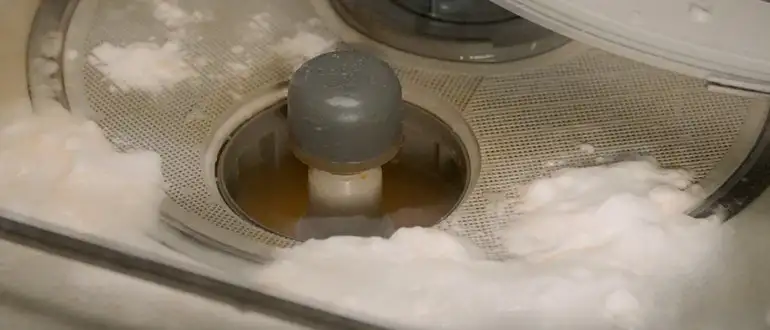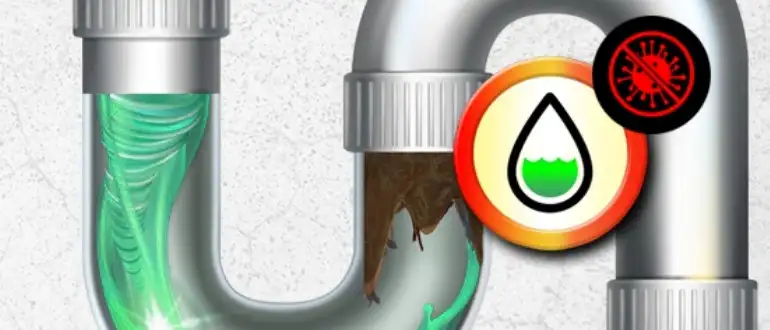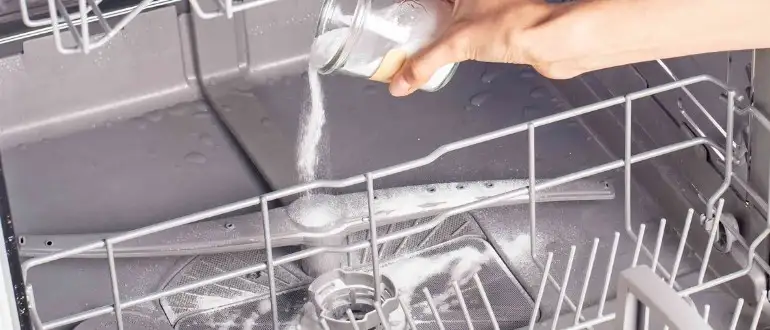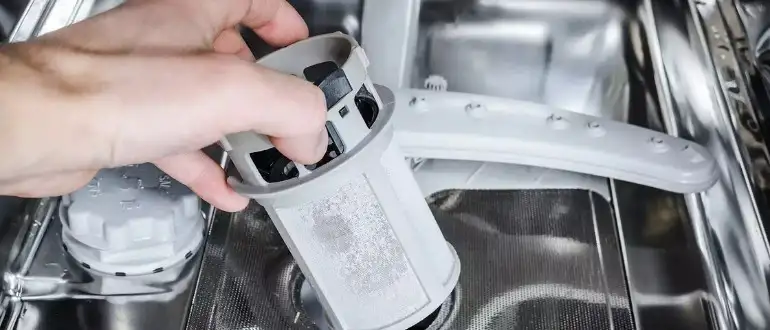People often get confused if it is possible to put drain cleaner in the dishwasher. Many people are curious to know about it.
Knowing if it is possible to do this is necessary to not go wrong and get the best cleaning experience.
Read this article to find out your answer and a detailed guideline for a safe and simple dishwashing experience.
Can You Put Drain Cleaner In A Dishwasher?
No. Because commercial drain cleaning agents contain toxic ingredients. So the residues can stay after unclogging the drain.

For future wash cycles, the residues can remain on your dishes, which can harm your health.
The drain cleaner damages your hose and other parts and can cause further mechanical problems, and you may have to buy new parts.
The reason to not use drain cleaner in a dishwasher
Dangers and Hazards:
The drain cleaner contains toxic ingredients, so the residues from the drain cleaner remain in your dishes after washing.

Even for your future wash, the drain cleaner can remain in your dishes and can be harmful to your health.
It can also cause mechanical problems by creating leaks in many places and can damage your dishwasher’s rubber.
Repairing :
The drain line connected to your dishwasher is where most clogs arise.
Use an auger or “plumbing snake” to remove the drain hose.
When operating the auger, exercise care. The auger might damage the hose or cut or penetrate your skin if misused.
Before starting the dishwasher, attach the drain pipe according to the user manual.
Other Things to Think About
Severe clogs can cause your dishwasher to drain unclean water from the dishwasher and the dirt can pile up.
Make sure to clean your waste disposal since it can link to some dishwashers and create clogs.
If you cannot identify the source of the clog or if your efforts to unclog the dishwasher fail, call a professional plumber.
Before any severe damage occurs, the plumber can unclog the drain.
Alternative Cleaning Methods

Put a mixture of white vinegar and baking soda into the drain pipe. This can aid in the dissolution of small materials that might block drains.
Allow almost 30 minutes to 1 hour for the mixture to rest before rinsing it in an empty dishwasher.
Preventing clogs by doing this once a month is an excellent maintenance practice.
How to clean the drainpipe of the dishwasher?
Here’s a step-by-step guide on how to clean the drainpipe of a dishwasher:
Step 1: Turn off the power supply
Before we get started, make sure to turn off the power supply to your dishwasher. Safety first, right?
Unplug it or disconnect it from the power source to ensure that you can safely work on the drainpipe without any risk of electrocution.
Step 2: Locate the drainpipe
Now that the power supply is turned off, let’s find the drainpipe. It’s usually located at the bottom of your dishwasher, beneath the lower spray arm.
You might need to remove the bottom dish rack to access it.
Step 3: Remove visible debris
Once you’ve found the drainpipe, take a paper towel or a soft-bristled brush and remove any visible debris or food particles from it.
Make sure to dispose of the debris in the trash and not down the sink to avoid causing a clog.
Step 4: Check for clogs
Using a flashlight, take a closer look at the drainpipe for any clogs or blockages. If you see any, don’t worry!
You can use a long, flexible cleaning brush to dislodge the clog and push it through the drainpipe.
Alternatively, you can use a plunger to force water through the drainpipe and clear any clogs.
Step 5: Run hot water through the drainpipe
After removing visible debris and clearing any clogs, run hot water through the drainpipe for a few minutes to flush out any remaining debris or dirt.
You can even add a cup of white vinegar to the hot water to help break down any grease or grime.
Step 6: Reassemble the dishwasher
Now that the drainpipe is clean, it’s time to put everything back together.
Reassemble the dishwasher by replacing the bottom dish rack and reconnecting the power supply.
Run a cycle of the dishwasher to make sure that the drainpipe is functioning properly.
Step 7: Clean the dishwasher regularly
To prevent future clogs and keep your dishwasher running smoothly, it’s important to clean it regularly.
This includes running a cycle with a dishwasher cleaner once a month, wiping down the interior with a damp cloth, and cleaning the filters and spray arms as needed.
There you have it! Following these steps will help you keep your dishwasher drainpipe clean and functioning properly, and ensure that your dishes come out clean every time.
What to do when the dishwasher is not draining?
Inspect the kitchen sink for sluggish drainage:
If your dishwasher drains slowly, your kitchen sink is likely suffering from the same issue.
Suppose you try to drain water and discover poor drainage. In such a case, there is most likely a clog anywhere between the dishwasher and the sink plumbing system.
Also, use sink unclogging tools like drain snakes.
Clean the fine filter:

The strainer isn’t the only filter that might cause sluggish draining; the upper filter can also have this problem. To avoid clogging and buildup, clean it well and secure it in place.
Clean, And Check The Drain Sump:
Instead of washing and reinstalling the strainer and upper filter, take your time to check the drain sump for particles and buildups.
Remove any standing water first, inspect for any residue, glass, or stickers on plates or mugs and discard them.
Before replacing the filters, double-check that the sump is clean.
To remove particles from difficult-to-reach areas, use a straightened clothes hanger. Just make sure you don’t break any sensitive components.
Clean the drain pump and non-return valve thoroughly:
Remove the hose from the drain pump and ensure that the non-return valve is working correctly.
It should only supply water toward the sink or trash disposal, not the other way around.
After that, remove the drain pump and examine it for obstructions. Check that the impeller can spin freely (with some resistance) and that nothing impedes it.
Return the drain pump and reconnect the hose, and the dishwasher is ready to use!
FAQs about using drain cleaner in a dishwasher:
Can Drain Cleaner Make The Clog In The Dishwasher Worse?
Yes. A chemical cleaner, in fact, can aggravate a clog by converting it into a more solid, congealed mass.
Like the one above, a drain cleaner might cause a partial loosening of the deposits, which can lead to a complete blockage farther down the line.
Especially if the movement through the pipes is slow!
What Can I Put In The Dishwasher To Unclog?
Use equal amounts of baking soda and vinegar to clean. Pour the baking soda and vinegar mixture into the bottom and allow it to settle down.
Can A Chemical Drain Opener Such As Liquid Plumber Help My Dishwasher If It’s Not Draining?
It is not advised to do so. It is better to replace or clean the drain and its lines by disassembling them, and this process is much simpler.
Also, drain openers work only on gravity drains, not on dishwashers. As dishwashers use a pump.
Final Thought:
There are many reasons behind dishwasher clogging. Using a drain cleaner as a remedy is never a good idea.
Unclog using a straightened clothes hanger or hose jet, or repair the malfunctioning non-return valve.
Always try the troubleshooting tips in this article before seeking expert assistance. And lastly, please avoid drain cleaner for unclogging. This is not the best resort to use.

